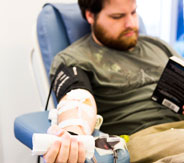Apheresis Blood Collection (ABC)
Apheresis blood collection, or ABC, is a special kind of blood donation. Instead of giving one pint of whole blood (as in a regular donation), an ABC donor gives only the components of blood needed for patients that day. ABC is made possible by an amazing machine that separates the components of your blood, retains certain components, and returns the rest to you—all with a single needle. It's a very efficient way of directly helping patients in hospitals. By collecting the optimal number of blood components at each donation, we can help ensure that these lifesaving products are available for the community.
Donor health and medical history requirements for ABC are the same as for a whole blood donation, with a few additional requirements. Each donation is based on gender, height, weight and hemoglobin (the number of red blood cells) count on the day of donation. These requirements are in place to ensure donor safety. One of our staff will use the blood collection machine and their expertise to determine what type of donation you can safely give that day. You may be recruited for an ABC donation on your first visit with us.
Donating Platelets
During a platelet donation, we will collect one, two, or three units of platelets. One of our medical technicians will recommend the number of units based on your weight, hemoglobin level, and platelet count that day. Platelet donations are accepted at all three of our donor centers.
You may donate platelets every 72 hours (3 days). However, there is a limit of 24 platelet donations per person per year. If it has been less than seven days since your last donation, a preliminary platelet count must be performed, which can only be done at our Palo Alto Center. Many of our dedicated platelet donors choose to give every two weeks of the year. Click here to schedule a donation at one of our centers. Please remember to increase intake of fluids, calcium, and iron at least two days before your appointment. This will help prevent donation reactions.
Special note: Due to a change in the Food & Drug Administration's (FDA) recommendations, we're changing the amount of time that must pass between taking aspirin and donating platelets. Beginning May 1, 2008, donors must be aspirin-free for 48 hours to donate platelets.
Why, you ask? Because aspirin reduces the potency and performance of your platelets. The more time between taking aspirin and donating blood, the better for the recipient. We're making this change because it will make transfusions more effective for patients in our community hospitals.
Donating Red Blood Cells
During a red blood cell donation, we will collect two units of red blood cells and return the other components to the donor. We refer to this as a double red blood cell donation, or "DRBC" for short. Gender, height, and weight are crucial in determining whether a person can give this type of donation. In general, women must be at least 5' 5" tall and weigh at least 150 pounds, and men must be at least 5' 1" tall and weigh at least 130 pounds. DRBC donors must also have a hemoglobin level of at least 13.3 g/dL.
Why are the requirements different for women and men? Because women and men have different total blood volumes (TBV)—even if they weigh the same amount. The standard of care dictates that no more than 15% of a person's TBV should be drawn at a time. Our apheresis machines determine TBV based on gender, height, weight and hemoglobin.
DRBC donations are only accepted on mobile blood drives and at our Palo Alto donor center.
Donors may only make a DRBC donation every 16 weeks. Click here to schedule a donation at one of our centers.
Donating other combinations of blood components
Based on your size, hemoglobin level, platelet count, and the current needs of our community, our medical technicians may determine that a different combination of blood components would be most efficient for a donation. The most common types are listed above, but other ABC options are one, two or three platelets; one, two or three plasmas; or any combination dependent on total blood volume and platelet count.

Galen Poulton enjoys a book while donating platelets. Photo by Erin Kunkel
Components of blood
Red blood cells transport oxygen and nutrients to the tissues and remove carbon dioxide and waste. Red blood cells are indicated for more than 70% of all transfusions. Accident victims, patients with ulcers and patients undergoing surgery use red blood cells.
Platelets act to induce clotting and control bleeding.
Plasma is 92% water, miscellaneous elements and 7% protein from which derivatives are made. Cryoprecipitate, antihemophilic factor and fresh frozen plasma can be given to patients who have hemophilia and other bleeding problems. Gamma Globulin is used to supplement the immune system in fighting disease such as hepatitis, and serum albumin is given to treat and prevent shock.
White blood cells protect the body against disease and infection. They move through the blood stream to attack and absorb bacteria and other "foreign" bodies. Since white blood cells are likely to cause a negative reaction in blood recipients, these cells are are removed from the blood donation and used for research.
